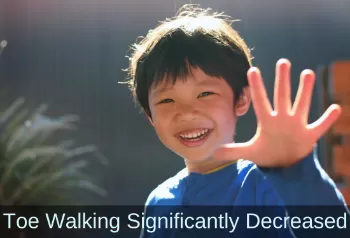Primitive Reflex Integration Case Studies
6-Year-Old Gains More Foot Function, Better Sensory Integration; Toe Walking Diminishes
Brain and Sensory Foundations tools help with sensory processing and gross motor skills.
This OT assessed her client as having retained Plantar and Babinski (foot) reflexes, contributing to his sensory defensiveness and toe walking. He could not tolerate brushing or weighted-vest sensory tools, hindering his treatment. After 4 weeks of rhythmic movement and reflex integration, his foot reflexes were well on their way to integrated, and he was already seeing dramatic improvements in his toe walking and sensory processing issues, clearing the way for more reflex integration to address other issues, including motor skills, poor attention, and impulsiveness.
Submitted by Julie Seen OTR/L

| Before | After |
|---|---|
| Could not tolerate brushing or weighted-vest sensory tools | Can tolerate the brushing/Thera pressure protocol and responds very well and can achieve relaxation in his whole body |
| Toe-walked | Toe-walking has significantly decreased, just happening when he gets excited |
6 y.o. boy with motor apraxia, sensory defensiveness, poor attention, in constant motion, impulsive, toe-walks, and poor midline integration. Could not tolerate brushing or weighted-vest sensory tools. Retained feet reflexes: plantar/Babinski, Rhythmic Movement Exercises- 1-4 as a regular home program – relax nervous system and pave the way to integrate reflexes.
In the Clinic once a week:
RM- Stimulation-Isometrics- followed by the following integration activities/games:
Belly crawl-pushing with feet- retrieving pebbles with toes and walking on sides of feet to place pebbles into a cup, walking with different foot positions skipping the toes since he is a toe walker (without song), and obstacle course with (pokey textured) stepping stones and balance beam.
Reasoning: I utilized the activities in the [Brain and Sensory Foundations course] manual directly for integration of the foot reflexes and I picked the pokey stepping stones and balance beam activities to further stimulate and with weight bearing on the feet, work all the muscles in the feet for balance. The pebbles activity I combined with the foot walks as they are both in the manual as integration activities.
Client Challenges/Preferences: He did not like songs with the RM so we counted instead; he liked to count as I provided the movement. He had an elaborate story for the obstacle course and why his feet couldn’t touch the floor (it changed each time, but he loved to supply the story as his contribution). I did not have the walking song, but we pretended to be different kinds of monsters with each different foot position.
Results following 4 weeks of treatment: Foot reflexes almost integrated. He occasionally responds every 4-5 trials but is markedly less reflexive. At first he was not able to curl his toes around a pebble to pick it up and is now able to pick it up and walk across the room to place it in a cup. He is now able to tolerate the brushing/Thera pressure protocol and responds very well and can achieve relaxation in his whole body. The RM also allows him to relax but is best at night because he gets so relaxed that he wants to sleep. His toe walking has significantly decreased and now it just happens when he gets excited and not as much throughout the day the way it used to. I plan to continue this protocol [from the Brain and Sensory Foundations course] longer to see if further gains can be made.
Impressions: Allowing the client to make their own contributions to the activities and the stories of the activities can be a great “buy in” for the program and compliance with the program.
[Edited for length and clarity; emphasis added]
*Disclaimer: The activities in the Brain and Sensory Foundations curriculum make use of the natural processes of neuroplasticity and development that are innately wired in the design of human beings to promote maturity and function. These activities appear to calm, organize, and mature the neuro-sensory-motor systems just as we see in the healthy development of human infants. Individual results may vary, and we do not claim to offer a diagnosis or cure for any specific condition or disorder. The Brain and Sensory Foundations activities appear to improve overall functioning resulting in measurable improvements for a range of conditions as demonstrated in over 1800 case studies from participants.

